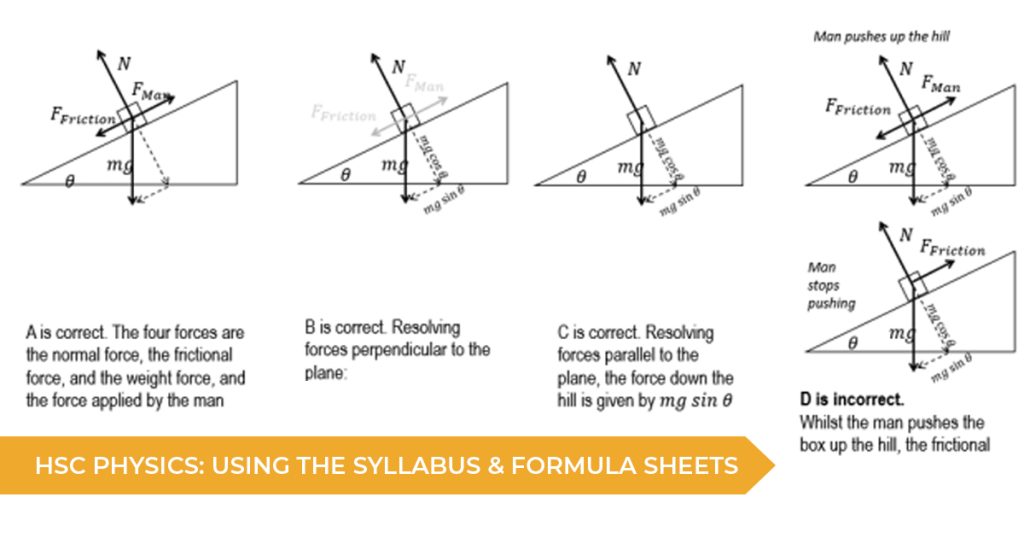HSC Physics has a lot of content in it, and managing it all can be very difficult.
What can be even harder is working out what you don’t know, and when to use which formula for a specific example.
Two key pieces of documentation are the physics syllabus and the formula sheet that all students should know how to use. The Physics syllabus provided by NESA gives an in-depth overview of the formulas, ideas, and experiments you will need to explain come exam time.
On the other hand, the formula sheet gives a rundown of all the formulas that may be used without proof in an exam. Both need to be used precisely to ensure that the correct progress is made throughout HSC Physics.
Here are some helpful tips on how to use the HSC Physics data sheet to your advantage:
Write your notes based on the syllabus
When writing notes, you should ready be amalgamating points from school notes, Talent books and your textbooks. These may vary in the way they are structured. For example, the textbook may structure concepts in a way that is more cohesive and can be read top down, instead of the structure provided by NESA. As such, when writing notes make each syllabus point a heading, and follow the structure provided in the syllabus. This is not to format your notes correctly, but instead it is an extremely reliable method in order to discern concepts that you have not covered or understood.
For example, you may know the Maths behind Geostationary and Low Earth orbits in HSC Physics Module 5, but the syllabus states that students should be able to:
“Predict quantitatively the orbital properties of planets and satellites in a variety of situations, including near the Earth and geostationary orbits, and relate these to their uses.”
As such when writing your notes out, you may realise that you also need to understand the different uses of these orbits, including their advantages and disadvantages.
RELATED: How To Study Smarter For HSC Physics
Using the syllabus as a tool allows you to work out what you do and don’t know, and can be used as an actual instrument to provide a more complete understanding, instead of just as a formatting mechanism.
Use the formula sheet wisely
Many students will, after deriving a formula in class ask “is this in the formula sheet?”
Upon hearing yes, will breathe a sigh of relief and forget the derivation that was just provided. The formula sheet is merely a tool, it gives you nothing more than formulas you can quote without proof. There is no content as to where to use them and when; and this can be the downfall of a lot of students.
An example of this is in Module 6. The formula for the force on a charged particle, moving at a constant velocity through a magnetic field is given by ![]() is the angle between the direction of the magnetic field and the velocity vector. In multiple choice questions, the examiners are aware that students may forget which angle is to be used, and as such will give the opposite angle in the triangle, or a completely useless one, which would lead to the wrong answer.
is the angle between the direction of the magnetic field and the velocity vector. In multiple choice questions, the examiners are aware that students may forget which angle is to be used, and as such will give the opposite angle in the triangle, or a completely useless one, which would lead to the wrong answer.
A deeper understanding would show that the force is experienced by a charged particle if its velocity vector is perpendicular to the direction of the magnetic field. The perpendicular component of the velocity vector may require you to take the sine component or the cos component, but the fact that the velocity component must be perpendicular is unchanged. As such, regardless of which angle is provided students should be able to deduce how to split the velocity vector and then apply the right-hand palm rule, instead of plugging the first angle they see into the formula.
The formula sheet will not provide, or explain, such intricacies as to how and when each formula should be used. Hence derivations should be remembered, and the background behind formulas is a must know in order to apply the correct formula in the correct manner at the right time.
Basing your notes on the syllabus and not relying on the formula sheet will, come exam time, lead to less stress during the exam – you won’t be worrying about which formula to use, and fewer doubts as to whether this content was covered.
Excel in Physics this year with the help of Talent 100. Learn more about our Year 11 and 12 Physics course structure, 1-1 tutorials and how we can get you on the right track for the HSC. Click here for more information, or how to get started with Talent 100.





